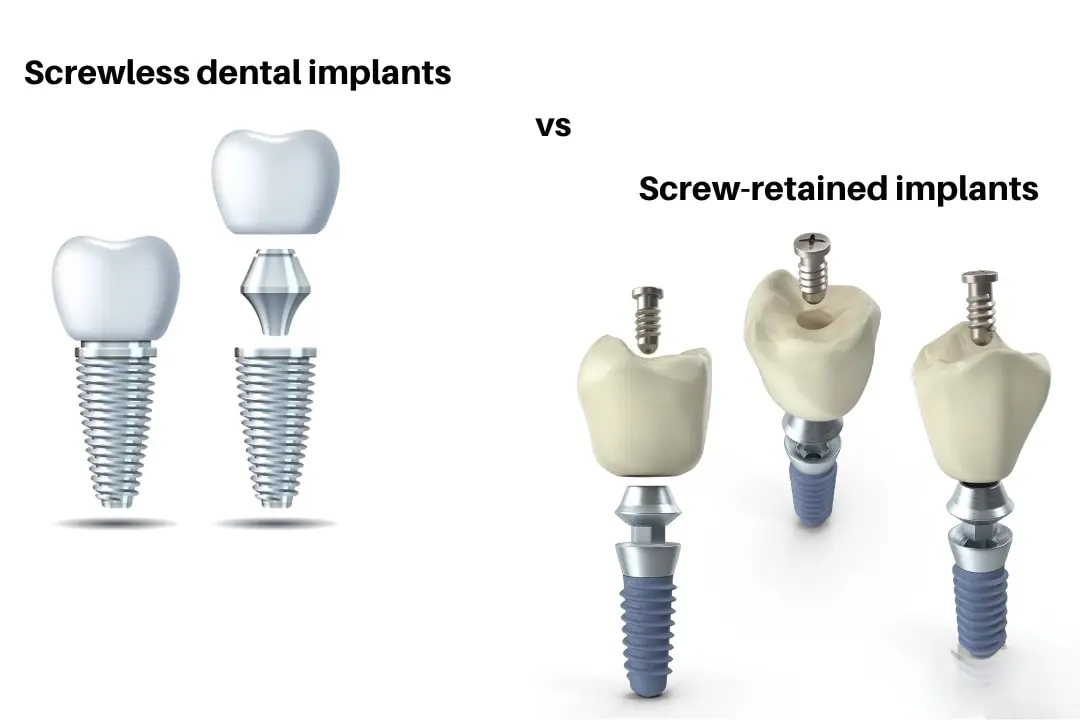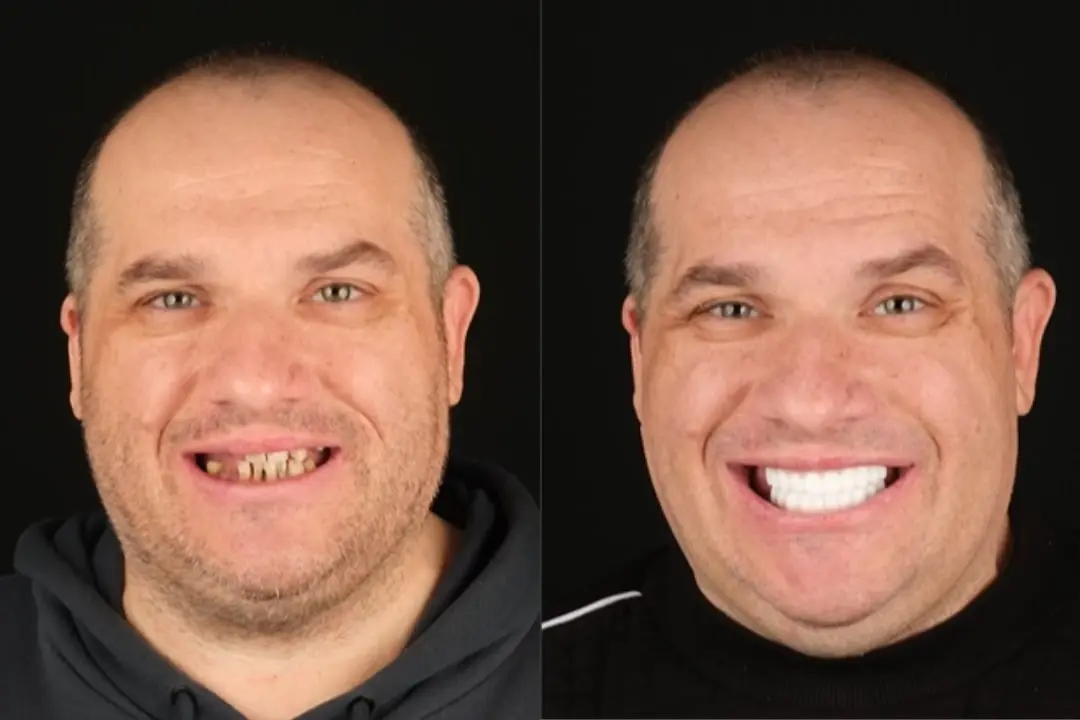What are screwless dental implants?
Screwless dental implants refer to an implant design that does not use screws to secure the abutment portion of the tooth, unlike traditional screw-retained implants. However, this name can be misleading because the system still includes a screw. These methods, called screwless, bonded or cemented dental implants, are secured with special adhesives or pressing techniques instead of abutment and crown screws. This design strengthens the connection between the implant and the prosthesis, while preventing screws from being visible from the outside.

One of the advantages of screwless implant systems is the reduced risk of screw loosening and easier installation. With traditional screw-retained implants, loosening of the screws can cause problems over time. Screwless teeth eliminate these problems and preserve the natural appearance of the tooth. However, these systems still have a screw inserted inside; the difference is in the fixation method.
Dental implants usually consist of a screw placed in the jawbone, the abutment (connecting piece), and the dental prosthesis placed on top of it. In the traditional screw-fixed system, a screw is used between the abutment and the dental prosthesis, while in screwless implants, this connection is provided by adhesives or special pressing techniques. As a result, screwless implants offer an advantageous option in terms of aesthetics and functionality, but still require a screw to secure the implant.
How do screwless dental implants work?
Screwless dental implants offer fast and aesthetic solutions for individuals experiencing tooth loss as an alternative to traditional screw systems.
Screwless implants are fixed with specially designed adaptation and adhesive techniques instead of using screws to place the tooth in the jawbone. The harmony between the implant and the abutment (connection piece) is perfectly ensured, and the dental prosthesis is fixed in place without the need for screws. This method is advantageous in terms of aesthetics because there are no screws or connection pieces visible from the outside.
The implant placement process is usually performed in a single session. This offers a time-saving solution for patients. In addition, the healing process is much faster since less tissue is cut. The use of adhesives ensures that the prosthesis fits properly and remains securely in place for a long time. With this method, implant treatment is less invasive and increases patient comfort.
As a result, screwless dental implants are an ideal option for patients looking for aesthetics, fast healing and a less invasive treatment.
Who can choose screwless dental implants?
Screwless dental implants have many advantages over conventional screw implants and can be preferred under certain conditions. So, for whom can these implants be suitable?
Those with low bone density
Screwless dental implants are an ideal solution for people who do not have sufficient bone density. It can also be successfully applied in patients with low bone density without the need for bone grafting.
Those who experience discomfort with traditional implants
Screwed implants can sometimes put pressure on the surrounding tissues and cause discomfort. Screwless implants create less discomfort during the healing process by applying low pressure.
Those who want a less invasive procedure
Screwless implants are perfect for those who fear surgical procedures or are looking for a quick treatment, as they require a shorter healing process and less surgical intervention.
Those at risk of implant loosening
Screwless implants provide a stronger fit than traditional implants and eliminate the risk of loosening. It is also an ideal choice for those with habits such as teeth grinding.
Aesthetic seekers
Screwless implants without visible screw holes provide a natural appearance. These implants may be a more suitable option for patients with aesthetic concerns.
What are the pros and cons of screwless dental implants?
Advantages
Screwless dental implants have many advantages. Firstly, these screwless systems provide an appearance closer to the natural structure of the tooth. In addition, the placement process is less invasive, which speeds up the healing process and provides a more comfortable experience for the patient. Another advantage is that the screwless system causes less trauma to the gums. This is especially important for patients with aesthetic concerns, as the scars and sutures of the gum are less prominent. In addition, screwless implants generally require less maintenance and offer a reliable solution in the long term.
Disadvantages
- Less durability: Screwless implants can be damaged more during daily chewing and biting than traditional screw implants, which reduces durability.
- Short lifespan: Such implants can often have a shorter lifespan, which creates a risk of premature failure.
- Reduced chewing performance: Screwless implants may not be able to provide full efficiency during chewing, which can impose limitations in terms of chewing efficiency and comfort.
- Maintenance issues and gum disease: There is a higher risk of periodontal disease, which can lead to implant failure.
- Repair difficulties: With screwless implants, in the event of deterioration of the crowns, the entire crown will have to be replaced, because they have a shorter life span.
As a result, while screwless dental implants offer advantages in terms of aesthetics and the healing process, they have some limitations in terms of durability and longevity.
Screwless or Screw Retained Implants: Which one is right for you?
Screw-in and screwless implants are both suitable for missing tooth restorations. However, there are some differences. Here is a comparison that will give you a better understanding of the differences between these two types of implants:
| Feature | Screwed dental implants | Cemented/Screwless implants |
|---|---|---|
| Attachment method | Screw-retained crown | Adhesive or cemented crown on abutment |
| Aesthetic appearance | Visible screw hole | No visible screw hole, more natural appearance |
| Repair and maintenance | Repair with simple screw adjustments | More difficult to fix or adjust |
| Risk of relaxation | Screws may loosen over time | Lower risk of loosening due to strong adhesive |
| Chewing pressure | Withstands high chewing pressure, especially suitable for back teeth | Suitable for front teeth that require lighter chewing |
| Placement time | Similar healing and placement time | Same healing process, only crown attachment differs |
| Care | Low maintenance, easy to adjust when screws loosen | Gum disease risk may be higher due to the use of adhesives |
Which type of implant is more suitable usually depends on the location of the missing tooth, the patient's aesthetic preferences and the requirements of the treatment. Screw-retained implants in Antalya are long-lasting and highly durable and perform particularly well in the posterior teeth. Screwless implants, on the other hand, are aesthetically ideal for front teeth. It is important to make a detailed assessment with your dentist to determine which implant option is more suitable.

Why should you prefer Simena Dental Clinic in Antalya for dental implants?
Simena Dental Clinic in Antalya is one of the leading clinics in the sector in dental implants with its expert physicians and modern treatment methods. Simena Dental, which has extensive experience in implants, including screw and ceramic dental implants, offers customized solutions for each patient. The clinic promises its patients a comfortable and safe treatment process by offering high quality at affordable prices. In addition, Simena Dental manages the treatment process in the best way by making a detailed preliminary assessment for each patient and achieves successful results.
